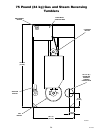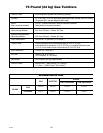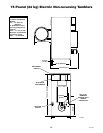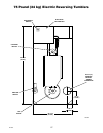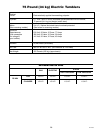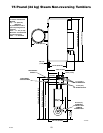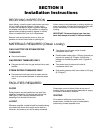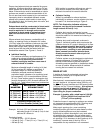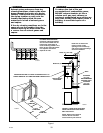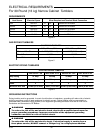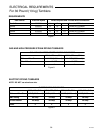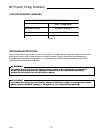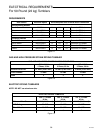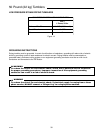
32
M412616
Proper sized exhaust ducts are essential for proper
operation. All elbows should be sweep type. Do not
install elbows with a radius less than shown in table
below. Exhaust ducts must be assembled so interior
surfaces are smooth to reduce accumulation of lint.
Do not use sheet metal screws to join vent sections.
Improperly sized or assembled ductwork causes
excess back pressure which results in slow drying,
lint collecting in duct, lint blowing back into room, and
increased fire hazard.
Exhaust ducts shall be constructed of sheet metal
or other noncombustible material. Such ducts
must be equivalent in strength and corrosion
resistance to ducts made of galvanized sheet
steel not less than 0.0195 inches (0.495 mm)
thick.
Where exhaust duct pierces a combustible wall or
ceiling, an opening having a diameter of 4 inches
(10.2 cm) larger than diameter of exhaust duct shall
be provided, with duct centered in opening. When
ducts pass through walls, ceilings, floors or partitions,
space around the duct shall be sealed with non-
combustible material. See
Figures 1, 2
and
3.
••
••
• Individual Venting
For maximum efficiency and performance, it is
preferred to exhaust tumbler(s) individually to
outdoors. At no point may cross area of
installed venting be less than cross area of
exhaust thimble of tumbler.
Maximum allowable length of venting is 14 feet
(4.3 m) and two 90° elbows or equivalent. If
equivalent length of a duct required for an
installation exceeds maximum allowable
equivalent length, diameter of a round duct must
be increased by 10% for each additional 20 feet
(6.1 m). Cross section area of a rectangular duct
must be increased by 20% for each additional 20
feet (6.1 m). Table below shows how to determine
equivalent venting:
Example: A 6-inch (15.2 cm) diameter duct’s
equivalent length of 14 feet (4.3 m) of duct
and two 90° elbows is:
Equivalent length
= 14 feet (4.3 m) + (2) 90° elbows
= 14 feet (4.3 m) + 7 feet (2.1 m) + 7 feet (2.1 m)
= 28 feet (8.5 m)
With tumbler in operation, airflow at any point in
duct must be at least 1200 feet (366 m) per
minute to insure that lint remains airborne.
••
••
• Collector Venting
While it is preferable to exhaust tumblers
individually to outdoors, a main collector duct may
be used if it is sized according to
Figure 3.
NOTE: This illustration indicates minimum
diameters, and should be increased if collector
length exceeds 20 feet (6.1 m).
Collector duct may be rectangular in cross
section, as long as area is not reduced. Provisions
should be made for lint removal and cleaning of
collector duct.
Collector duct must be tapered, as shown in
Figure 3.
Individual tumbler ducts must enter the
collector duct at a 45° angle in direction of air flow.
Never connect a tumbler duct at a 90° angle to
collector duct. Doing so will cause excessive
back pressure, resulting in poor performance.
Never connect two tumbler exhaust ducts
directly across from each other at point of
entry to collector duct.
Collector system must be designed so static back
pressure measured 12 inches (30.5 cm) from
exhaust thimble does not exceed maximum
allowable pressure specified on installation sticker
on rear of tumbler. Measured with all tumblers
running that are vented into collector.
MAKE-UP AIR
A tumbler is forced air exhausted and requires
provisions for make-up air to replace the air
exhausted by tumbler.
Manufacturer’s recommended make-up air opening
for each tumbler is 144 square inches (928 sq. cm)
for 30 and 50 pound tumblers and 195 square inches
(1258 sq. cm) for 75 pound tumblers. At a minimum,
tumblers must have at least 1 in
2
(2.54 cm
2
) of
opening for every 1000 BTU/hr (252 Kcal/hr) of
input rating for proper combustion.
Example: A tumbler with a rated input of 120,000
BTU/hr (30,240 Kcal) requires 120 in
2
(774 cm
2
) of free opening.
Protective louvers in opening to outdoors can reduce
air movement by approximately 40%. Opening must
compensate for area taken up by louvers.
Make-up air openings for a room containing
tumbler(s) and/or gas fired hot water heater or other
gravity vented appliances must be increased
sufficiently to prevent downdrafts in any vents when
all tumblers are in operation. Do not locate gravity
vented appliances between tumbler(s) and make-up
air openings. If it is necessary to duct make-up air to
tumbler(s), increase area of work by 25% to
compensate for any restriction in air movement.
DUCT
DIAMETER
EQUIVALENT LENGTH OF
STRAIGHT DUCT
6" (15.2 cm)
8" (20.3 cm)
10" (25.4 cm)
12" (30.5 cm)
One 90° elbow = 7' (2.1 m)
One 90° elbow = 9.3' (2.83 m)
One 90° elbow = 11.6' (3.5 m)
One 90° elbow = 14' (4.3 m)
Equivalent Length (feet) (m) =
1.17 x Duct Diameter (inches) (cm)



